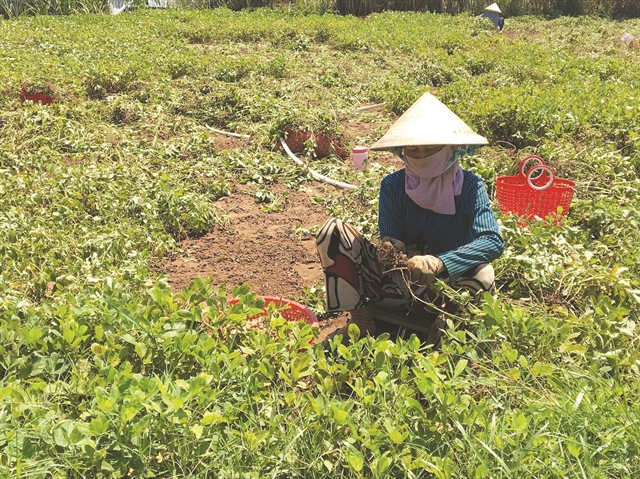 Society
Society

The Cửu Long (Mekong) Delta province of Trà Vinh has expanded production of peanut growing during the rainy season to meet demand for seeds and raise farmers' incomes.

|
| Farmers harvest peanuts grown during the 2018-19 winter-spring crop in Trà Vinh Province’s Cầu Ngang District. — VNA/VNS Photo Thanh Hòa |
TRÀ VINH — The Cửu Long (Mekong) Delta province of Trà Vinh has expanded production of peanut growing during the rainy season to meet demand for seeds and raise farmers' incomes.
The province, which is one of the delta’s largest peanut producers, produces only 15-25 per cent of peanut seeds and has to buy the rest from south-eastern and central regions.
In the 2018 autumn-winter crop, Trà Vinh University and the IFAD-funded Project for Adaptation to Climate Change in the Mekong Delta in Trà Vinh Province (AMD Trà Vinh) kicked off a pilot model for growing peanut seeds in the rainy season in Cầu Ngang District.
Seventeen farming households in Cầu Ngang’s Long Sơn Commune participated in the model and grew a total of 4.5ha of peanut seeds.
Under the pilot model, financial support was given to participating households to cover the cost of peanut seeds for cultivation and 30 per cent of the cost of fertiliser.
The farmers also received instruction in growing techniques suited to the rainy season.
Farmers generally grow only a small quantity of peanuts in the rainy season because the yield and quality is only 50 per cent of peanut yields grown in the winter-spring crop.
The participating households have harvested 7.5 tonnes of peanut seeds per hectare and earned a profit of VNĐ22 million (US$944) a hectare.
Trịnh Ngọc Ái, director of Trà Vinh University’s Biotechnology Centre, said the average yield per hectare of peanuts grown in the province has been more than 8 tonnes per hectare, the country’s highest.
Peanuts grown in the province have high quality, bright peel, and are suitable for processing and export, he said.
Most of the peanuts are usually grown during the winter-spring crop.
The province grows about 4,400ha of peanuts each year, mostly in Cầu Ngang and Duyên Hải districts and Duyên Hải Town.
Peanuts are the key crop of more than 2,000 households in Cầu Ngang, according to the district’s Agriculture and Rural Development Bureau.
Last year, the province’s People’s Committee spent VNĐ12 billion ($516,380) to improve peanut value chains between 2018 and 2020.
Households and companies involved in peanut cultivation, processing and trading are given support from local government agencies.
The province’s People’s Committee targets increasing the peanut area to 8,450ha with an annual output of 45,000 tonnes next year.
It also plans to develop a 500ha area for producing peanut seeds for cultivation. The area will produce two crops of peanut seeds with an annual output of 3,500 tonnes.
Sand dunes
The province has also restructured agricultural production in coastal sand dunes where peanut vines can grow, according to the local Department of Agriculture and Rural Development.
The province has more than 17,000ha of coastal sand dunes, the largest area in the delta. The dunes normally lack water in the dry season and are not suited for growing rice.
Because of their potential, peanuts and coconut have been chosen by the province for further development to enhance their value.
In the first half of the year, the province planted 3,862ha of peanuts, nearly equal to the same period last year, according to the local Statistics Office. — VNS